Influence of External Factors on John Lewis: A Strategic Analysis
VerifiedAdded on 2023/01/19
|11
|3599
|61
AI Summary
This assignment discusses the influence of macro and micro environment on John Lewis and its strategies. It applies frameworks like PEST analysis and Ansoff's growth matrix to evaluate external forces and formulate a strategic plan.
Contribute Materials
Your contribution can guide someone’s learning journey. Share your
documents today.
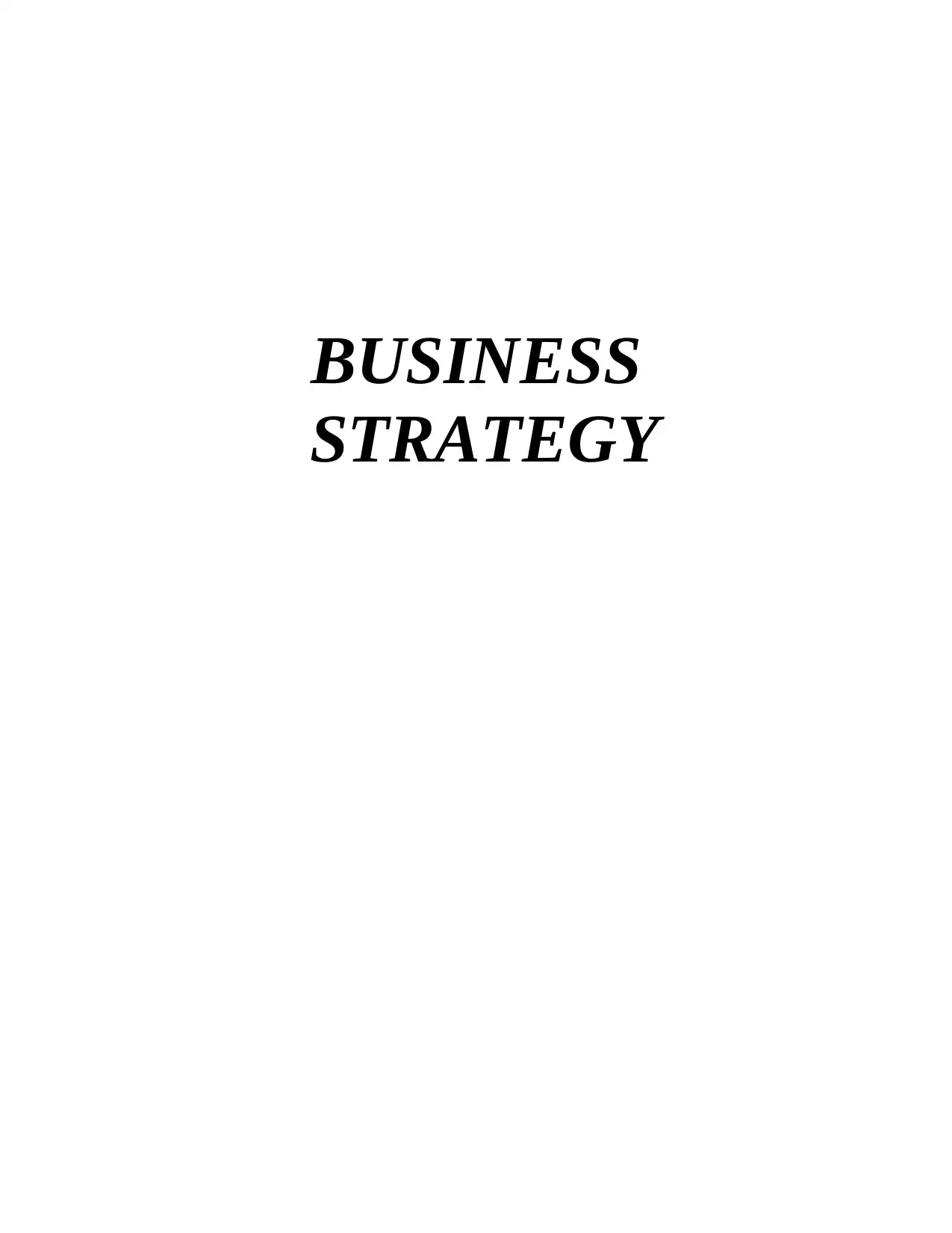
BUSINESS
STRATEGY
STRATEGY
Secure Best Marks with AI Grader
Need help grading? Try our AI Grader for instant feedback on your assignments.
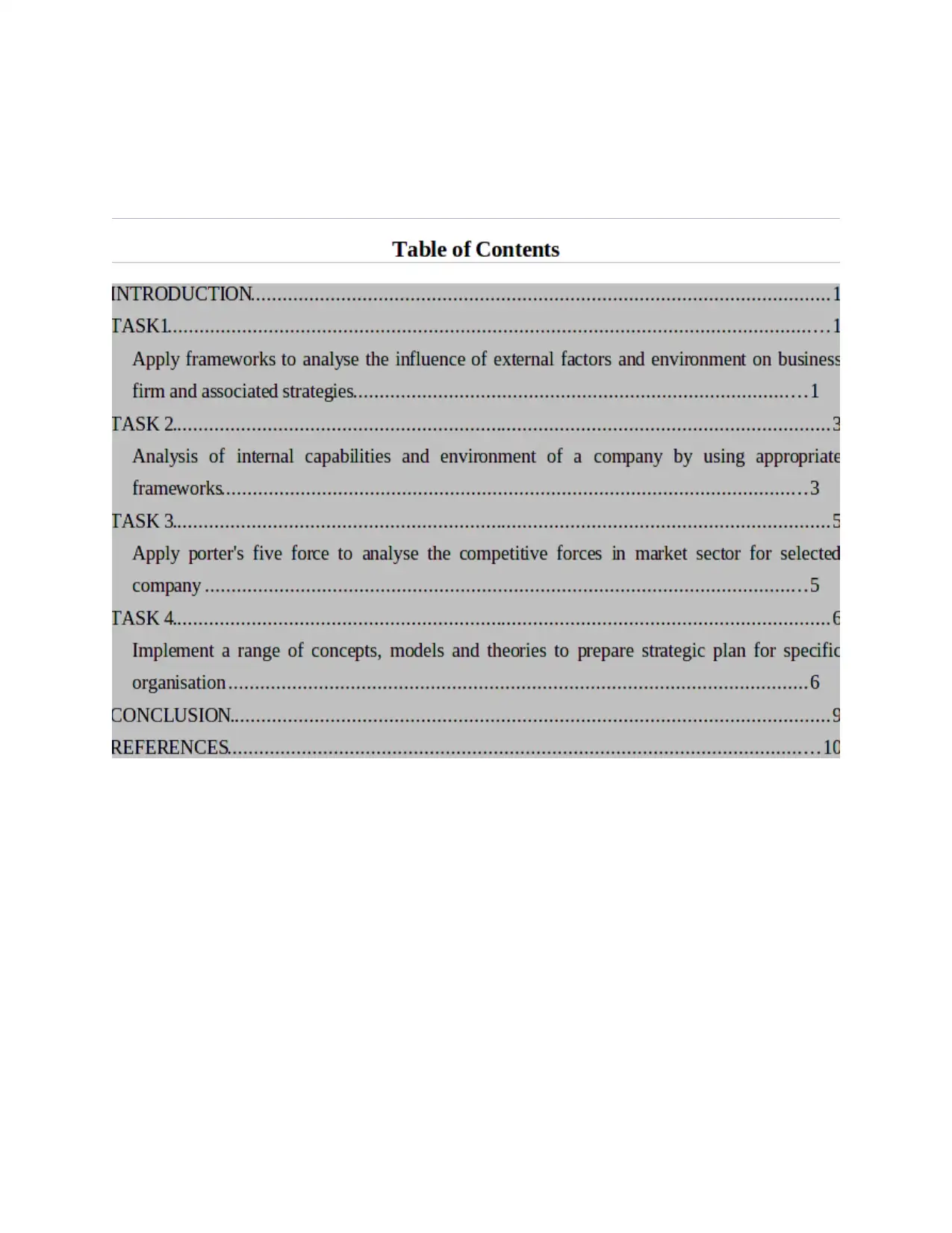
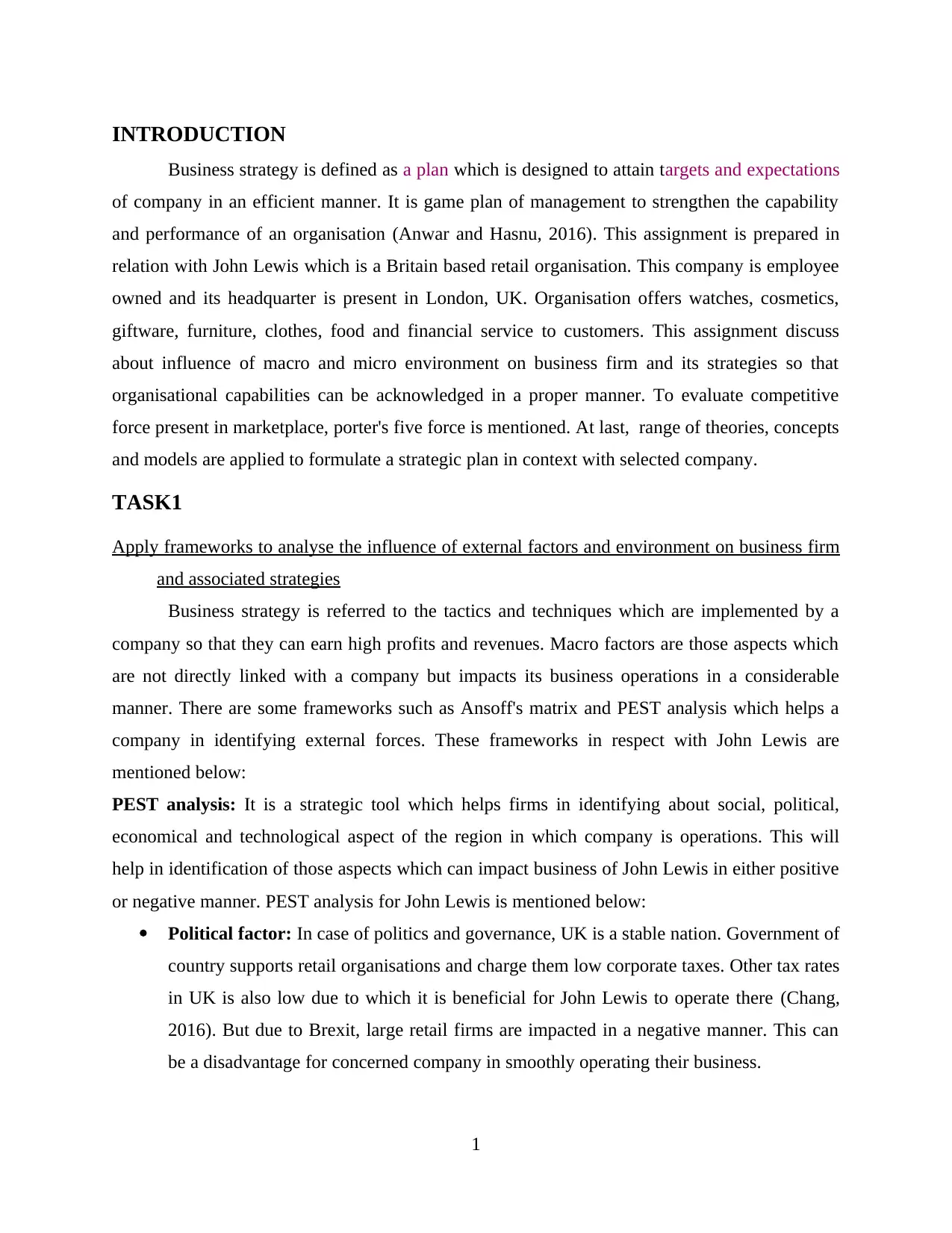
INTRODUCTION
Business strategy is defined as a plan which is designed to attain targets and expectations
of company in an efficient manner. It is game plan of management to strengthen the capability
and performance of an organisation (Anwar and Hasnu, 2016). This assignment is prepared in
relation with John Lewis which is a Britain based retail organisation. This company is employee
owned and its headquarter is present in London, UK. Organisation offers watches, cosmetics,
giftware, furniture, clothes, food and financial service to customers. This assignment discuss
about influence of macro and micro environment on business firm and its strategies so that
organisational capabilities can be acknowledged in a proper manner. To evaluate competitive
force present in marketplace, porter's five force is mentioned. At last, range of theories, concepts
and models are applied to formulate a strategic plan in context with selected company.
TASK1
Apply frameworks to analyse the influence of external factors and environment on business firm
and associated strategies
Business strategy is referred to the tactics and techniques which are implemented by a
company so that they can earn high profits and revenues. Macro factors are those aspects which
are not directly linked with a company but impacts its business operations in a considerable
manner. There are some frameworks such as Ansoff's matrix and PEST analysis which helps a
company in identifying external forces. These frameworks in respect with John Lewis are
mentioned below:
PEST analysis: It is a strategic tool which helps firms in identifying about social, political,
economical and technological aspect of the region in which company is operations. This will
help in identification of those aspects which can impact business of John Lewis in either positive
or negative manner. PEST analysis for John Lewis is mentioned below:
Political factor: In case of politics and governance, UK is a stable nation. Government of
country supports retail organisations and charge them low corporate taxes. Other tax rates
in UK is also low due to which it is beneficial for John Lewis to operate there (Chang,
2016). But due to Brexit, large retail firms are impacted in a negative manner. This can
be a disadvantage for concerned company in smoothly operating their business.
1
Business strategy is defined as a plan which is designed to attain targets and expectations
of company in an efficient manner. It is game plan of management to strengthen the capability
and performance of an organisation (Anwar and Hasnu, 2016). This assignment is prepared in
relation with John Lewis which is a Britain based retail organisation. This company is employee
owned and its headquarter is present in London, UK. Organisation offers watches, cosmetics,
giftware, furniture, clothes, food and financial service to customers. This assignment discuss
about influence of macro and micro environment on business firm and its strategies so that
organisational capabilities can be acknowledged in a proper manner. To evaluate competitive
force present in marketplace, porter's five force is mentioned. At last, range of theories, concepts
and models are applied to formulate a strategic plan in context with selected company.
TASK1
Apply frameworks to analyse the influence of external factors and environment on business firm
and associated strategies
Business strategy is referred to the tactics and techniques which are implemented by a
company so that they can earn high profits and revenues. Macro factors are those aspects which
are not directly linked with a company but impacts its business operations in a considerable
manner. There are some frameworks such as Ansoff's matrix and PEST analysis which helps a
company in identifying external forces. These frameworks in respect with John Lewis are
mentioned below:
PEST analysis: It is a strategic tool which helps firms in identifying about social, political,
economical and technological aspect of the region in which company is operations. This will
help in identification of those aspects which can impact business of John Lewis in either positive
or negative manner. PEST analysis for John Lewis is mentioned below:
Political factor: In case of politics and governance, UK is a stable nation. Government of
country supports retail organisations and charge them low corporate taxes. Other tax rates
in UK is also low due to which it is beneficial for John Lewis to operate there (Chang,
2016). But due to Brexit, large retail firms are impacted in a negative manner. This can
be a disadvantage for concerned company in smoothly operating their business.
1
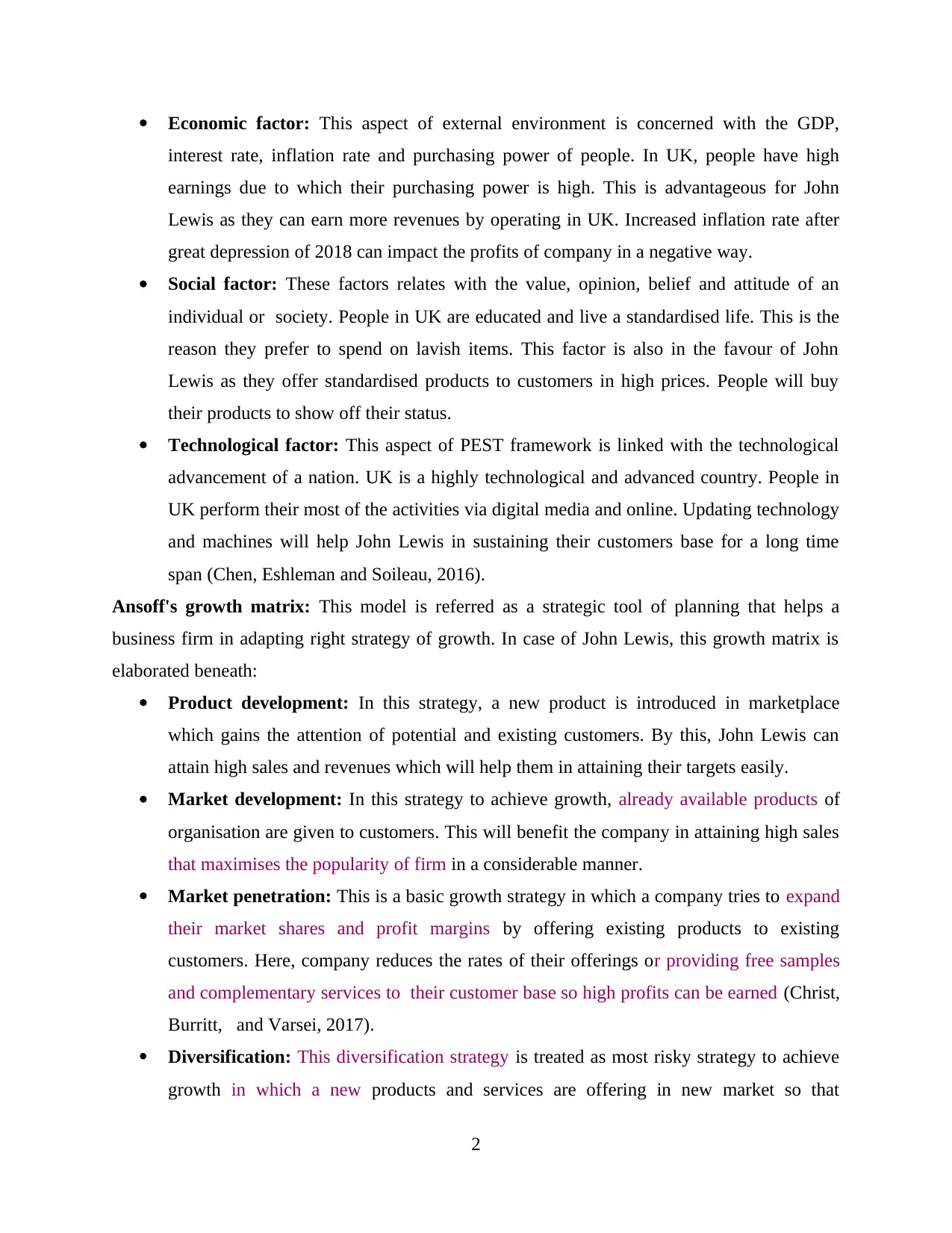
Economic factor: This aspect of external environment is concerned with the GDP,
interest rate, inflation rate and purchasing power of people. In UK, people have high
earnings due to which their purchasing power is high. This is advantageous for John
Lewis as they can earn more revenues by operating in UK. Increased inflation rate after
great depression of 2018 can impact the profits of company in a negative way.
Social factor: These factors relates with the value, opinion, belief and attitude of an
individual or society. People in UK are educated and live a standardised life. This is the
reason they prefer to spend on lavish items. This factor is also in the favour of John
Lewis as they offer standardised products to customers in high prices. People will buy
their products to show off their status.
Technological factor: This aspect of PEST framework is linked with the technological
advancement of a nation. UK is a highly technological and advanced country. People in
UK perform their most of the activities via digital media and online. Updating technology
and machines will help John Lewis in sustaining their customers base for a long time
span (Chen, Eshleman and Soileau, 2016).
Ansoff's growth matrix: This model is referred as a strategic tool of planning that helps a
business firm in adapting right strategy of growth. In case of John Lewis, this growth matrix is
elaborated beneath:
Product development: In this strategy, a new product is introduced in marketplace
which gains the attention of potential and existing customers. By this, John Lewis can
attain high sales and revenues which will help them in attaining their targets easily.
Market development: In this strategy to achieve growth, already available products of
organisation are given to customers. This will benefit the company in attaining high sales
that maximises the popularity of firm in a considerable manner.
Market penetration: This is a basic growth strategy in which a company tries to expand
their market shares and profit margins by offering existing products to existing
customers. Here, company reduces the rates of their offerings or providing free samples
and complementary services to their customer base so high profits can be earned (Christ,
Burritt, and Varsei, 2017).
Diversification: This diversification strategy is treated as most risky strategy to achieve
growth in which a new products and services are offering in new market so that
2
interest rate, inflation rate and purchasing power of people. In UK, people have high
earnings due to which their purchasing power is high. This is advantageous for John
Lewis as they can earn more revenues by operating in UK. Increased inflation rate after
great depression of 2018 can impact the profits of company in a negative way.
Social factor: These factors relates with the value, opinion, belief and attitude of an
individual or society. People in UK are educated and live a standardised life. This is the
reason they prefer to spend on lavish items. This factor is also in the favour of John
Lewis as they offer standardised products to customers in high prices. People will buy
their products to show off their status.
Technological factor: This aspect of PEST framework is linked with the technological
advancement of a nation. UK is a highly technological and advanced country. People in
UK perform their most of the activities via digital media and online. Updating technology
and machines will help John Lewis in sustaining their customers base for a long time
span (Chen, Eshleman and Soileau, 2016).
Ansoff's growth matrix: This model is referred as a strategic tool of planning that helps a
business firm in adapting right strategy of growth. In case of John Lewis, this growth matrix is
elaborated beneath:
Product development: In this strategy, a new product is introduced in marketplace
which gains the attention of potential and existing customers. By this, John Lewis can
attain high sales and revenues which will help them in attaining their targets easily.
Market development: In this strategy to achieve growth, already available products of
organisation are given to customers. This will benefit the company in attaining high sales
that maximises the popularity of firm in a considerable manner.
Market penetration: This is a basic growth strategy in which a company tries to expand
their market shares and profit margins by offering existing products to existing
customers. Here, company reduces the rates of their offerings or providing free samples
and complementary services to their customer base so high profits can be earned (Christ,
Burritt, and Varsei, 2017).
Diversification: This diversification strategy is treated as most risky strategy to achieve
growth in which a new products and services are offering in new market so that
2
Secure Best Marks with AI Grader
Need help grading? Try our AI Grader for instant feedback on your assignments.
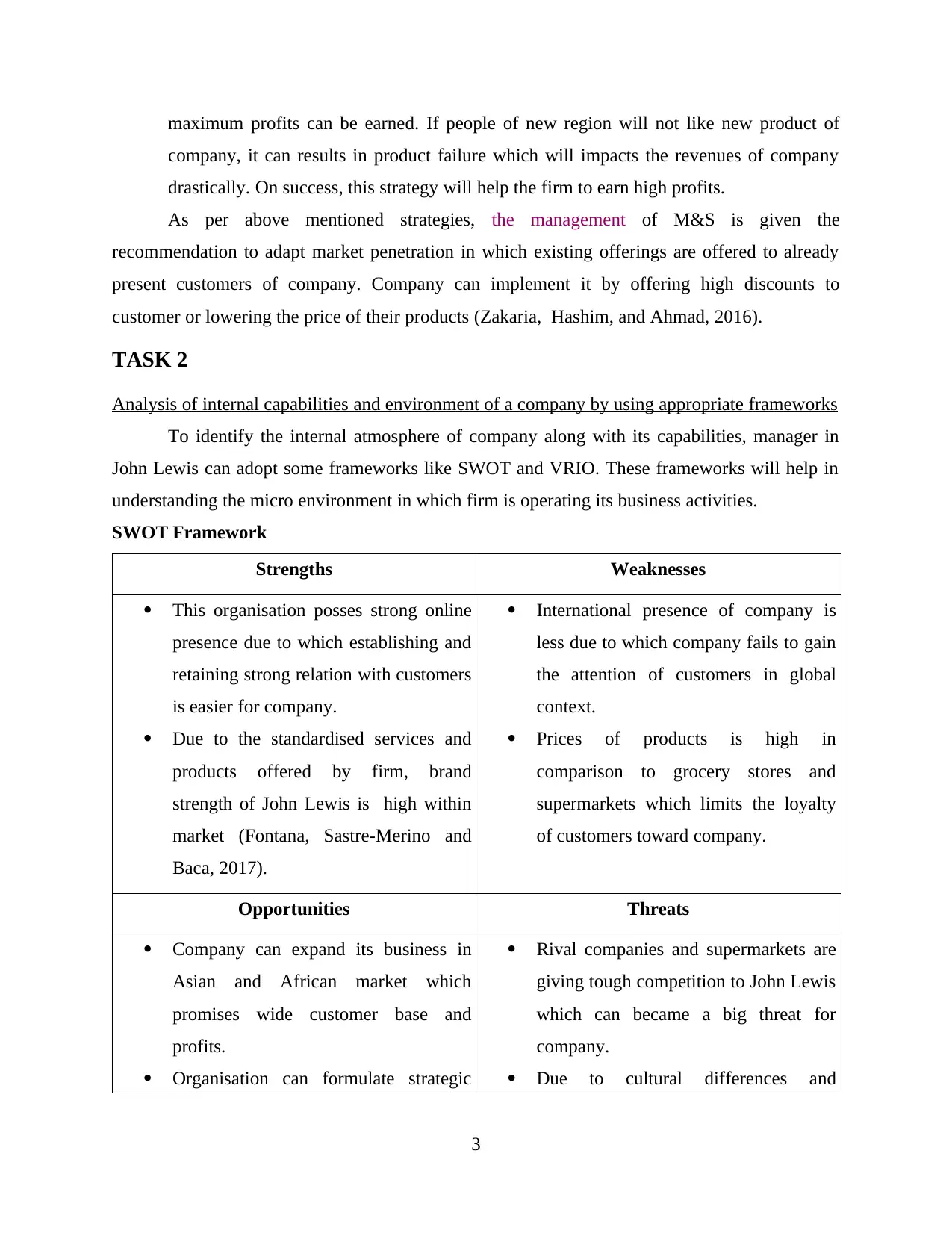
maximum profits can be earned. If people of new region will not like new product of
company, it can results in product failure which will impacts the revenues of company
drastically. On success, this strategy will help the firm to earn high profits.
As per above mentioned strategies, the management of M&S is given the
recommendation to adapt market penetration in which existing offerings are offered to already
present customers of company. Company can implement it by offering high discounts to
customer or lowering the price of their products (Zakaria, Hashim, and Ahmad, 2016).
TASK 2
Analysis of internal capabilities and environment of a company by using appropriate frameworks
To identify the internal atmosphere of company along with its capabilities, manager in
John Lewis can adopt some frameworks like SWOT and VRIO. These frameworks will help in
understanding the micro environment in which firm is operating its business activities.
SWOT Framework
Strengths Weaknesses
This organisation posses strong online
presence due to which establishing and
retaining strong relation with customers
is easier for company.
Due to the standardised services and
products offered by firm, brand
strength of John Lewis is high within
market (Fontana, Sastre-Merino and
Baca, 2017).
International presence of company is
less due to which company fails to gain
the attention of customers in global
context.
Prices of products is high in
comparison to grocery stores and
supermarkets which limits the loyalty
of customers toward company.
Opportunities Threats
Company can expand its business in
Asian and African market which
promises wide customer base and
profits.
Organisation can formulate strategic
Rival companies and supermarkets are
giving tough competition to John Lewis
which can became a big threat for
company.
Due to cultural differences and
3
company, it can results in product failure which will impacts the revenues of company
drastically. On success, this strategy will help the firm to earn high profits.
As per above mentioned strategies, the management of M&S is given the
recommendation to adapt market penetration in which existing offerings are offered to already
present customers of company. Company can implement it by offering high discounts to
customer or lowering the price of their products (Zakaria, Hashim, and Ahmad, 2016).
TASK 2
Analysis of internal capabilities and environment of a company by using appropriate frameworks
To identify the internal atmosphere of company along with its capabilities, manager in
John Lewis can adopt some frameworks like SWOT and VRIO. These frameworks will help in
understanding the micro environment in which firm is operating its business activities.
SWOT Framework
Strengths Weaknesses
This organisation posses strong online
presence due to which establishing and
retaining strong relation with customers
is easier for company.
Due to the standardised services and
products offered by firm, brand
strength of John Lewis is high within
market (Fontana, Sastre-Merino and
Baca, 2017).
International presence of company is
less due to which company fails to gain
the attention of customers in global
context.
Prices of products is high in
comparison to grocery stores and
supermarkets which limits the loyalty
of customers toward company.
Opportunities Threats
Company can expand its business in
Asian and African market which
promises wide customer base and
profits.
Organisation can formulate strategic
Rival companies and supermarkets are
giving tough competition to John Lewis
which can became a big threat for
company.
Due to cultural differences and
3
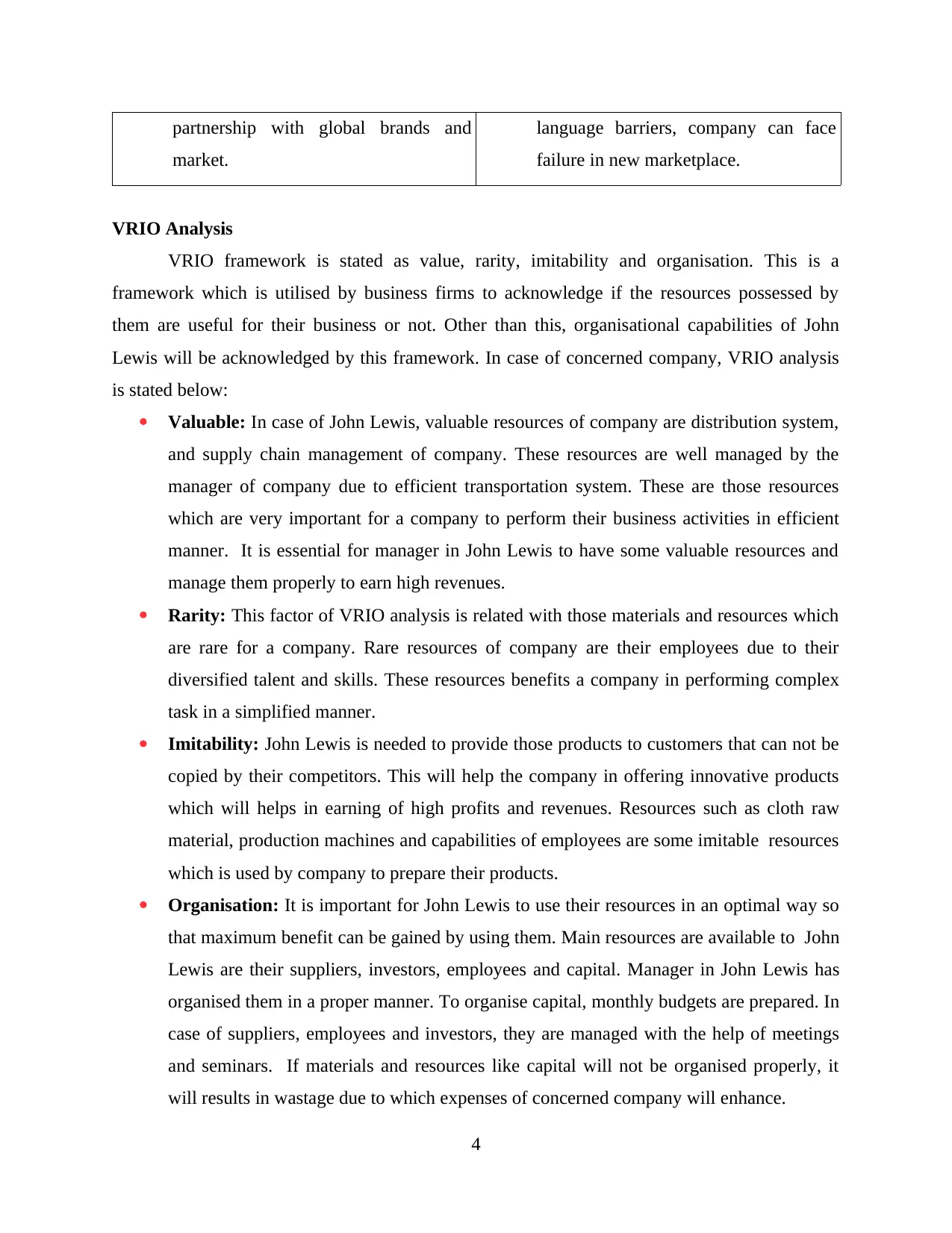
partnership with global brands and
market.
language barriers, company can face
failure in new marketplace.
VRIO Analysis
VRIO framework is stated as value, rarity, imitability and organisation. This is a
framework which is utilised by business firms to acknowledge if the resources possessed by
them are useful for their business or not. Other than this, organisational capabilities of John
Lewis will be acknowledged by this framework. In case of concerned company, VRIO analysis
is stated below:
Valuable: In case of John Lewis, valuable resources of company are distribution system,
and supply chain management of company. These resources are well managed by the
manager of company due to efficient transportation system. These are those resources
which are very important for a company to perform their business activities in efficient
manner. It is essential for manager in John Lewis to have some valuable resources and
manage them properly to earn high revenues.
Rarity: This factor of VRIO analysis is related with those materials and resources which
are rare for a company. Rare resources of company are their employees due to their
diversified talent and skills. These resources benefits a company in performing complex
task in a simplified manner.
Imitability: John Lewis is needed to provide those products to customers that can not be
copied by their competitors. This will help the company in offering innovative products
which will helps in earning of high profits and revenues. Resources such as cloth raw
material, production machines and capabilities of employees are some imitable resources
which is used by company to prepare their products.
Organisation: It is important for John Lewis to use their resources in an optimal way so
that maximum benefit can be gained by using them. Main resources are available to John
Lewis are their suppliers, investors, employees and capital. Manager in John Lewis has
organised them in a proper manner. To organise capital, monthly budgets are prepared. In
case of suppliers, employees and investors, they are managed with the help of meetings
and seminars. If materials and resources like capital will not be organised properly, it
will results in wastage due to which expenses of concerned company will enhance.
4
market.
language barriers, company can face
failure in new marketplace.
VRIO Analysis
VRIO framework is stated as value, rarity, imitability and organisation. This is a
framework which is utilised by business firms to acknowledge if the resources possessed by
them are useful for their business or not. Other than this, organisational capabilities of John
Lewis will be acknowledged by this framework. In case of concerned company, VRIO analysis
is stated below:
Valuable: In case of John Lewis, valuable resources of company are distribution system,
and supply chain management of company. These resources are well managed by the
manager of company due to efficient transportation system. These are those resources
which are very important for a company to perform their business activities in efficient
manner. It is essential for manager in John Lewis to have some valuable resources and
manage them properly to earn high revenues.
Rarity: This factor of VRIO analysis is related with those materials and resources which
are rare for a company. Rare resources of company are their employees due to their
diversified talent and skills. These resources benefits a company in performing complex
task in a simplified manner.
Imitability: John Lewis is needed to provide those products to customers that can not be
copied by their competitors. This will help the company in offering innovative products
which will helps in earning of high profits and revenues. Resources such as cloth raw
material, production machines and capabilities of employees are some imitable resources
which is used by company to prepare their products.
Organisation: It is important for John Lewis to use their resources in an optimal way so
that maximum benefit can be gained by using them. Main resources are available to John
Lewis are their suppliers, investors, employees and capital. Manager in John Lewis has
organised them in a proper manner. To organise capital, monthly budgets are prepared. In
case of suppliers, employees and investors, they are managed with the help of meetings
and seminars. If materials and resources like capital will not be organised properly, it
will results in wastage due to which expenses of concerned company will enhance.
4
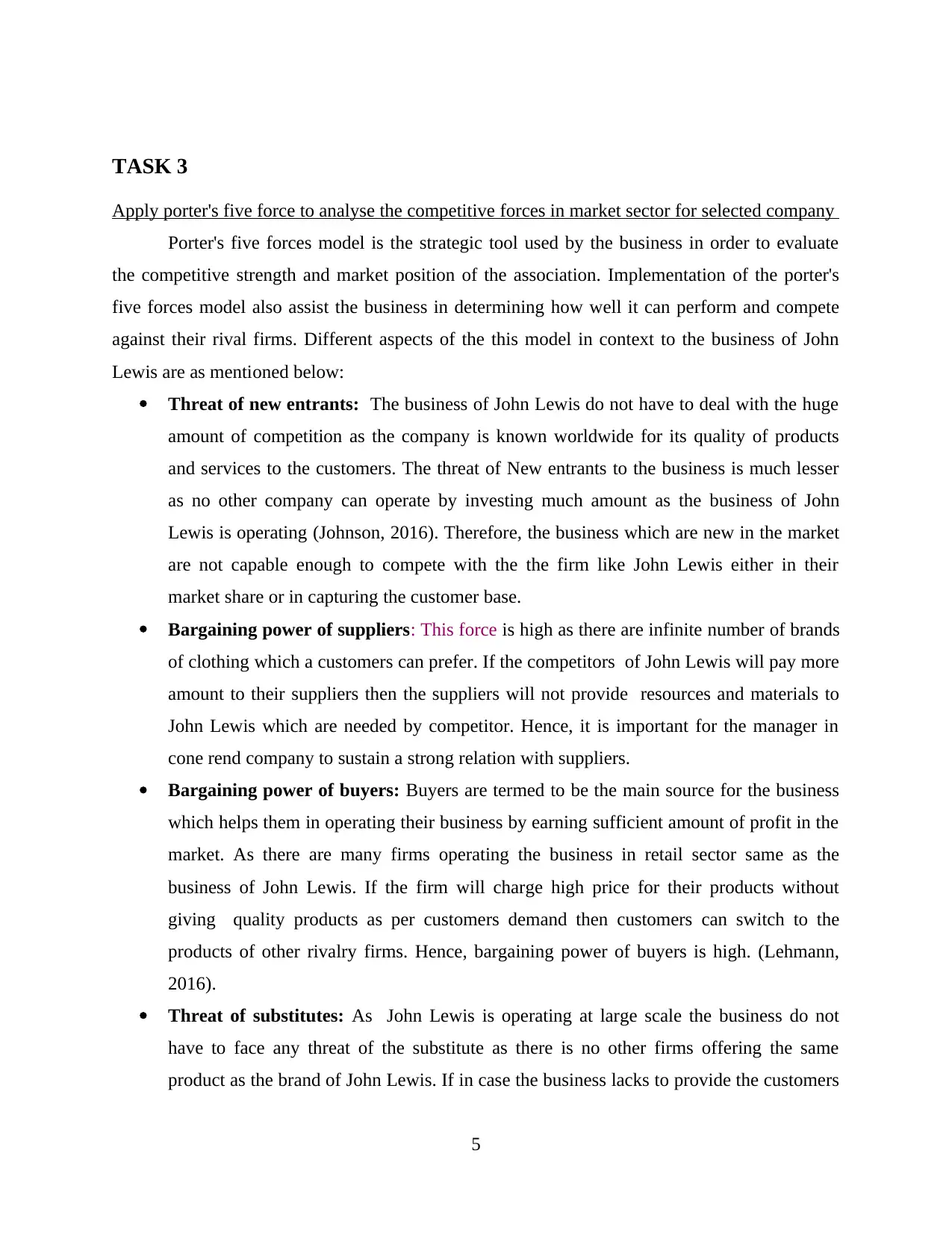
TASK 3
Apply porter's five force to analyse the competitive forces in market sector for selected company
Porter's five forces model is the strategic tool used by the business in order to evaluate
the competitive strength and market position of the association. Implementation of the porter's
five forces model also assist the business in determining how well it can perform and compete
against their rival firms. Different aspects of the this model in context to the business of John
Lewis are as mentioned below:
Threat of new entrants: The business of John Lewis do not have to deal with the huge
amount of competition as the company is known worldwide for its quality of products
and services to the customers. The threat of New entrants to the business is much lesser
as no other company can operate by investing much amount as the business of John
Lewis is operating (Johnson, 2016). Therefore, the business which are new in the market
are not capable enough to compete with the the firm like John Lewis either in their
market share or in capturing the customer base.
Bargaining power of suppliers: This force is high as there are infinite number of brands
of clothing which a customers can prefer. If the competitors of John Lewis will pay more
amount to their suppliers then the suppliers will not provide resources and materials to
John Lewis which are needed by competitor. Hence, it is important for the manager in
cone rend company to sustain a strong relation with suppliers.
Bargaining power of buyers: Buyers are termed to be the main source for the business
which helps them in operating their business by earning sufficient amount of profit in the
market. As there are many firms operating the business in retail sector same as the
business of John Lewis. If the firm will charge high price for their products without
giving quality products as per customers demand then customers can switch to the
products of other rivalry firms. Hence, bargaining power of buyers is high. (Lehmann,
2016).
Threat of substitutes: As John Lewis is operating at large scale the business do not
have to face any threat of the substitute as there is no other firms offering the same
product as the brand of John Lewis. If in case the business lacks to provide the customers
5
Apply porter's five force to analyse the competitive forces in market sector for selected company
Porter's five forces model is the strategic tool used by the business in order to evaluate
the competitive strength and market position of the association. Implementation of the porter's
five forces model also assist the business in determining how well it can perform and compete
against their rival firms. Different aspects of the this model in context to the business of John
Lewis are as mentioned below:
Threat of new entrants: The business of John Lewis do not have to deal with the huge
amount of competition as the company is known worldwide for its quality of products
and services to the customers. The threat of New entrants to the business is much lesser
as no other company can operate by investing much amount as the business of John
Lewis is operating (Johnson, 2016). Therefore, the business which are new in the market
are not capable enough to compete with the the firm like John Lewis either in their
market share or in capturing the customer base.
Bargaining power of suppliers: This force is high as there are infinite number of brands
of clothing which a customers can prefer. If the competitors of John Lewis will pay more
amount to their suppliers then the suppliers will not provide resources and materials to
John Lewis which are needed by competitor. Hence, it is important for the manager in
cone rend company to sustain a strong relation with suppliers.
Bargaining power of buyers: Buyers are termed to be the main source for the business
which helps them in operating their business by earning sufficient amount of profit in the
market. As there are many firms operating the business in retail sector same as the
business of John Lewis. If the firm will charge high price for their products without
giving quality products as per customers demand then customers can switch to the
products of other rivalry firms. Hence, bargaining power of buyers is high. (Lehmann,
2016).
Threat of substitutes: As John Lewis is operating at large scale the business do not
have to face any threat of the substitute as there is no other firms offering the same
product as the brand of John Lewis. If in case the business lacks to provide the customers
5
Paraphrase This Document
Need a fresh take? Get an instant paraphrase of this document with our AI Paraphraser
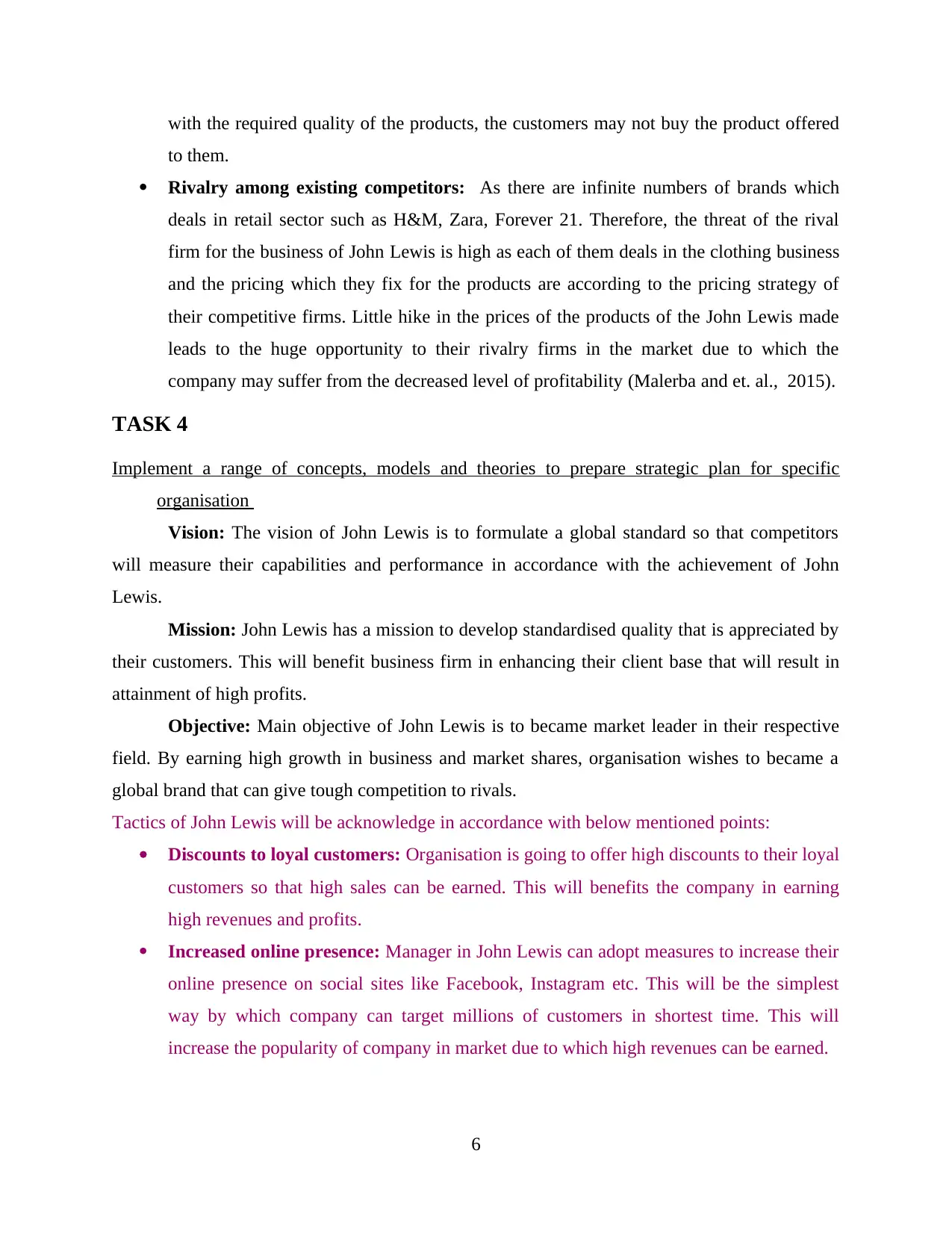
with the required quality of the products, the customers may not buy the product offered
to them.
Rivalry among existing competitors: As there are infinite numbers of brands which
deals in retail sector such as H&M, Zara, Forever 21. Therefore, the threat of the rival
firm for the business of John Lewis is high as each of them deals in the clothing business
and the pricing which they fix for the products are according to the pricing strategy of
their competitive firms. Little hike in the prices of the products of the John Lewis made
leads to the huge opportunity to their rivalry firms in the market due to which the
company may suffer from the decreased level of profitability (Malerba and et. al., 2015).
TASK 4
Implement a range of concepts, models and theories to prepare strategic plan for specific
organisation
Vision: The vision of John Lewis is to formulate a global standard so that competitors
will measure their capabilities and performance in accordance with the achievement of John
Lewis.
Mission: John Lewis has a mission to develop standardised quality that is appreciated by
their customers. This will benefit business firm in enhancing their client base that will result in
attainment of high profits.
Objective: Main objective of John Lewis is to became market leader in their respective
field. By earning high growth in business and market shares, organisation wishes to became a
global brand that can give tough competition to rivals.
Tactics of John Lewis will be acknowledge in accordance with below mentioned points:
Discounts to loyal customers: Organisation is going to offer high discounts to their loyal
customers so that high sales can be earned. This will benefits the company in earning
high revenues and profits.
Increased online presence: Manager in John Lewis can adopt measures to increase their
online presence on social sites like Facebook, Instagram etc. This will be the simplest
way by which company can target millions of customers in shortest time. This will
increase the popularity of company in market due to which high revenues can be earned.
6
to them.
Rivalry among existing competitors: As there are infinite numbers of brands which
deals in retail sector such as H&M, Zara, Forever 21. Therefore, the threat of the rival
firm for the business of John Lewis is high as each of them deals in the clothing business
and the pricing which they fix for the products are according to the pricing strategy of
their competitive firms. Little hike in the prices of the products of the John Lewis made
leads to the huge opportunity to their rivalry firms in the market due to which the
company may suffer from the decreased level of profitability (Malerba and et. al., 2015).
TASK 4
Implement a range of concepts, models and theories to prepare strategic plan for specific
organisation
Vision: The vision of John Lewis is to formulate a global standard so that competitors
will measure their capabilities and performance in accordance with the achievement of John
Lewis.
Mission: John Lewis has a mission to develop standardised quality that is appreciated by
their customers. This will benefit business firm in enhancing their client base that will result in
attainment of high profits.
Objective: Main objective of John Lewis is to became market leader in their respective
field. By earning high growth in business and market shares, organisation wishes to became a
global brand that can give tough competition to rivals.
Tactics of John Lewis will be acknowledge in accordance with below mentioned points:
Discounts to loyal customers: Organisation is going to offer high discounts to their loyal
customers so that high sales can be earned. This will benefits the company in earning
high revenues and profits.
Increased online presence: Manager in John Lewis can adopt measures to increase their
online presence on social sites like Facebook, Instagram etc. This will be the simplest
way by which company can target millions of customers in shortest time. This will
increase the popularity of company in market due to which high revenues can be earned.
6
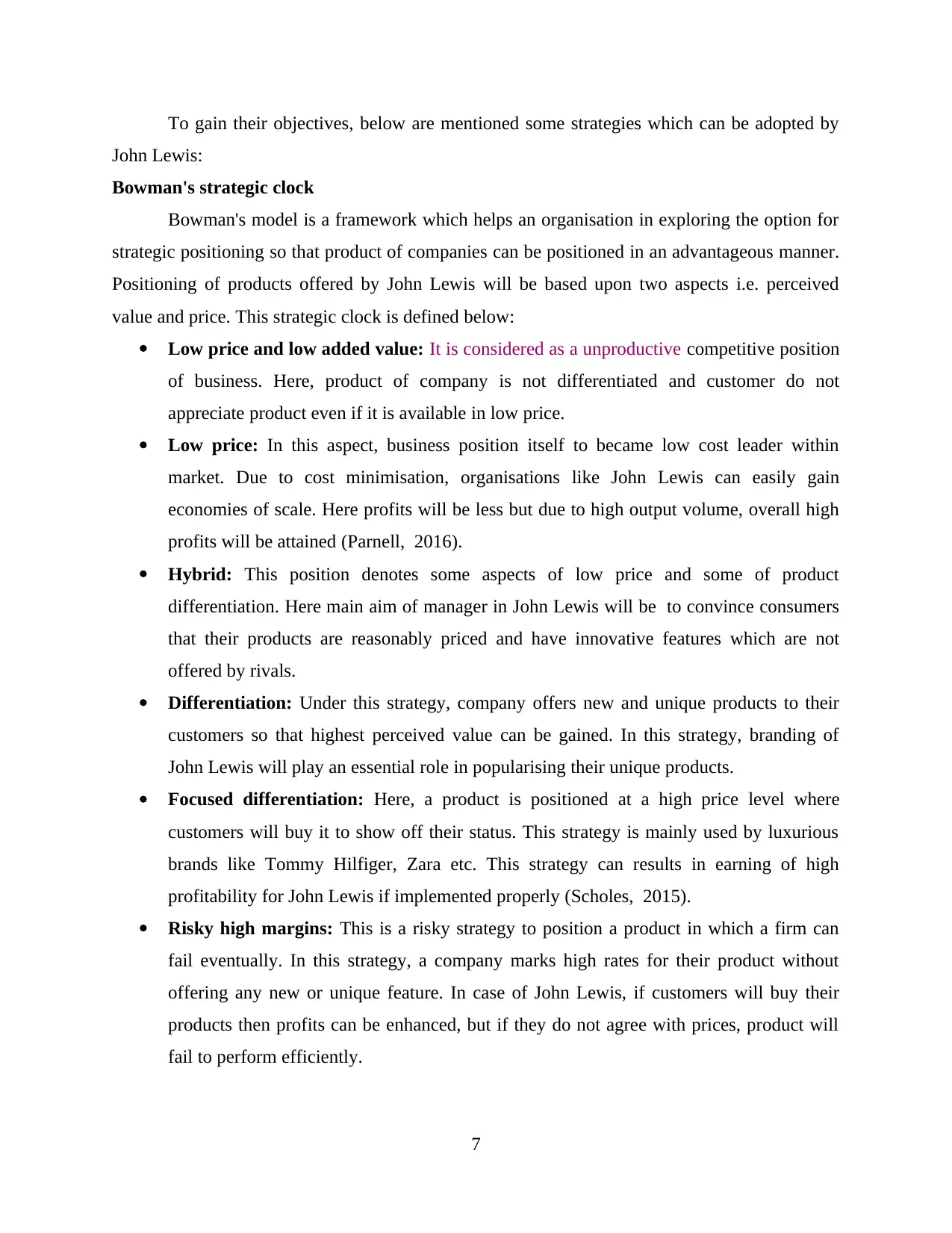
To gain their objectives, below are mentioned some strategies which can be adopted by
John Lewis:
Bowman's strategic clock
Bowman's model is a framework which helps an organisation in exploring the option for
strategic positioning so that product of companies can be positioned in an advantageous manner.
Positioning of products offered by John Lewis will be based upon two aspects i.e. perceived
value and price. This strategic clock is defined below:
Low price and low added value: It is considered as a unproductive competitive position
of business. Here, product of company is not differentiated and customer do not
appreciate product even if it is available in low price.
Low price: In this aspect, business position itself to became low cost leader within
market. Due to cost minimisation, organisations like John Lewis can easily gain
economies of scale. Here profits will be less but due to high output volume, overall high
profits will be attained (Parnell, 2016).
Hybrid: This position denotes some aspects of low price and some of product
differentiation. Here main aim of manager in John Lewis will be to convince consumers
that their products are reasonably priced and have innovative features which are not
offered by rivals.
Differentiation: Under this strategy, company offers new and unique products to their
customers so that highest perceived value can be gained. In this strategy, branding of
John Lewis will play an essential role in popularising their unique products.
Focused differentiation: Here, a product is positioned at a high price level where
customers will buy it to show off their status. This strategy is mainly used by luxurious
brands like Tommy Hilfiger, Zara etc. This strategy can results in earning of high
profitability for John Lewis if implemented properly (Scholes, 2015).
Risky high margins: This is a risky strategy to position a product in which a firm can
fail eventually. In this strategy, a company marks high rates for their product without
offering any new or unique feature. In case of John Lewis, if customers will buy their
products then profits can be enhanced, but if they do not agree with prices, product will
fail to perform efficiently.
7
John Lewis:
Bowman's strategic clock
Bowman's model is a framework which helps an organisation in exploring the option for
strategic positioning so that product of companies can be positioned in an advantageous manner.
Positioning of products offered by John Lewis will be based upon two aspects i.e. perceived
value and price. This strategic clock is defined below:
Low price and low added value: It is considered as a unproductive competitive position
of business. Here, product of company is not differentiated and customer do not
appreciate product even if it is available in low price.
Low price: In this aspect, business position itself to became low cost leader within
market. Due to cost minimisation, organisations like John Lewis can easily gain
economies of scale. Here profits will be less but due to high output volume, overall high
profits will be attained (Parnell, 2016).
Hybrid: This position denotes some aspects of low price and some of product
differentiation. Here main aim of manager in John Lewis will be to convince consumers
that their products are reasonably priced and have innovative features which are not
offered by rivals.
Differentiation: Under this strategy, company offers new and unique products to their
customers so that highest perceived value can be gained. In this strategy, branding of
John Lewis will play an essential role in popularising their unique products.
Focused differentiation: Here, a product is positioned at a high price level where
customers will buy it to show off their status. This strategy is mainly used by luxurious
brands like Tommy Hilfiger, Zara etc. This strategy can results in earning of high
profitability for John Lewis if implemented properly (Scholes, 2015).
Risky high margins: This is a risky strategy to position a product in which a firm can
fail eventually. In this strategy, a company marks high rates for their product without
offering any new or unique feature. In case of John Lewis, if customers will buy their
products then profits can be enhanced, but if they do not agree with prices, product will
fail to perform efficiently.
7
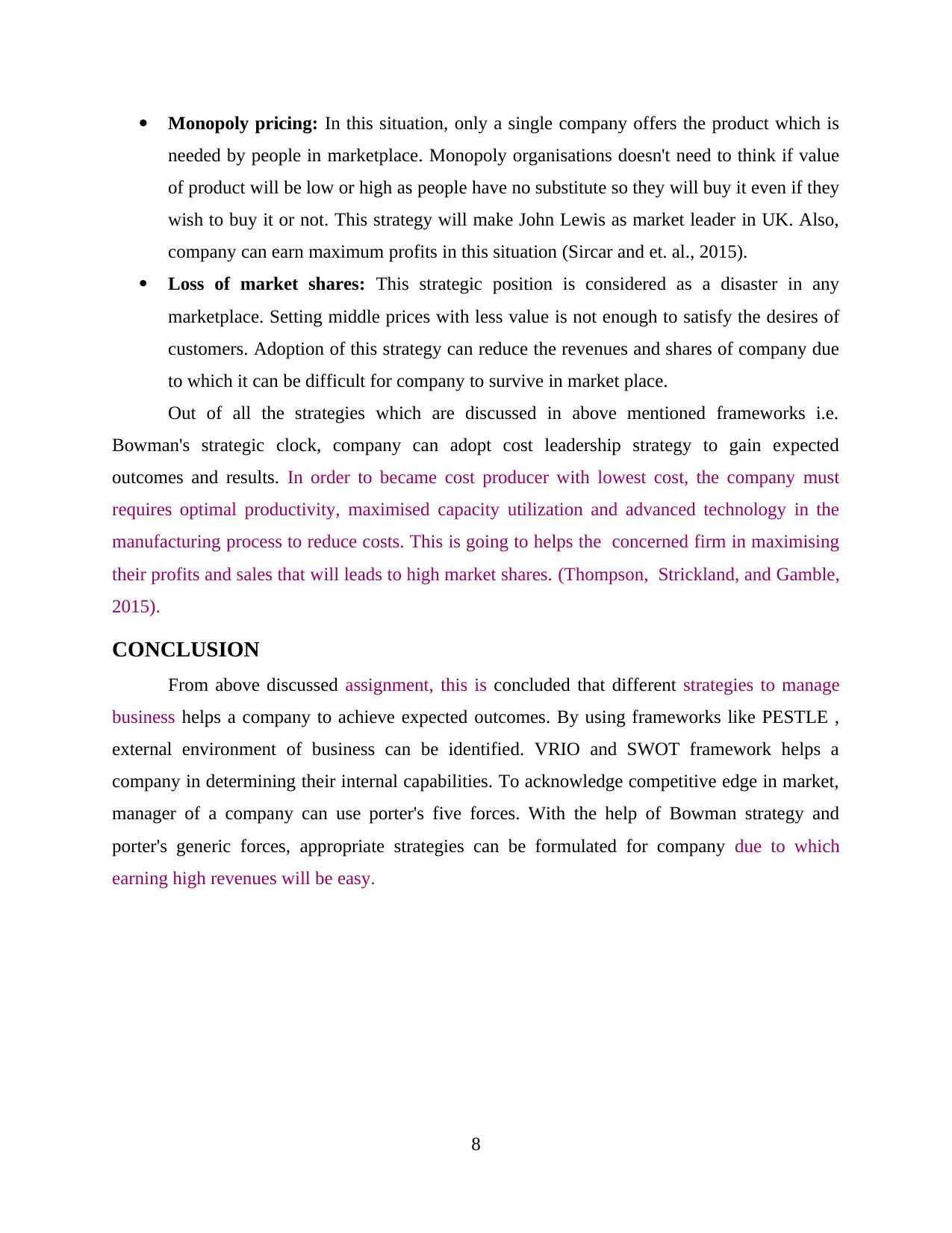
Monopoly pricing: In this situation, only a single company offers the product which is
needed by people in marketplace. Monopoly organisations doesn't need to think if value
of product will be low or high as people have no substitute so they will buy it even if they
wish to buy it or not. This strategy will make John Lewis as market leader in UK. Also,
company can earn maximum profits in this situation (Sircar and et. al., 2015).
Loss of market shares: This strategic position is considered as a disaster in any
marketplace. Setting middle prices with less value is not enough to satisfy the desires of
customers. Adoption of this strategy can reduce the revenues and shares of company due
to which it can be difficult for company to survive in market place.
Out of all the strategies which are discussed in above mentioned frameworks i.e.
Bowman's strategic clock, company can adopt cost leadership strategy to gain expected
outcomes and results. In order to became cost producer with lowest cost, the company must
requires optimal productivity, maximised capacity utilization and advanced technology in the
manufacturing process to reduce costs. This is going to helps the concerned firm in maximising
their profits and sales that will leads to high market shares. (Thompson, Strickland, and Gamble,
2015).
CONCLUSION
From above discussed assignment, this is concluded that different strategies to manage
business helps a company to achieve expected outcomes. By using frameworks like PESTLE ,
external environment of business can be identified. VRIO and SWOT framework helps a
company in determining their internal capabilities. To acknowledge competitive edge in market,
manager of a company can use porter's five forces. With the help of Bowman strategy and
porter's generic forces, appropriate strategies can be formulated for company due to which
earning high revenues will be easy.
8
needed by people in marketplace. Monopoly organisations doesn't need to think if value
of product will be low or high as people have no substitute so they will buy it even if they
wish to buy it or not. This strategy will make John Lewis as market leader in UK. Also,
company can earn maximum profits in this situation (Sircar and et. al., 2015).
Loss of market shares: This strategic position is considered as a disaster in any
marketplace. Setting middle prices with less value is not enough to satisfy the desires of
customers. Adoption of this strategy can reduce the revenues and shares of company due
to which it can be difficult for company to survive in market place.
Out of all the strategies which are discussed in above mentioned frameworks i.e.
Bowman's strategic clock, company can adopt cost leadership strategy to gain expected
outcomes and results. In order to became cost producer with lowest cost, the company must
requires optimal productivity, maximised capacity utilization and advanced technology in the
manufacturing process to reduce costs. This is going to helps the concerned firm in maximising
their profits and sales that will leads to high market shares. (Thompson, Strickland, and Gamble,
2015).
CONCLUSION
From above discussed assignment, this is concluded that different strategies to manage
business helps a company to achieve expected outcomes. By using frameworks like PESTLE ,
external environment of business can be identified. VRIO and SWOT framework helps a
company in determining their internal capabilities. To acknowledge competitive edge in market,
manager of a company can use porter's five forces. With the help of Bowman strategy and
porter's generic forces, appropriate strategies can be formulated for company due to which
earning high revenues will be easy.
8
Secure Best Marks with AI Grader
Need help grading? Try our AI Grader for instant feedback on your assignments.
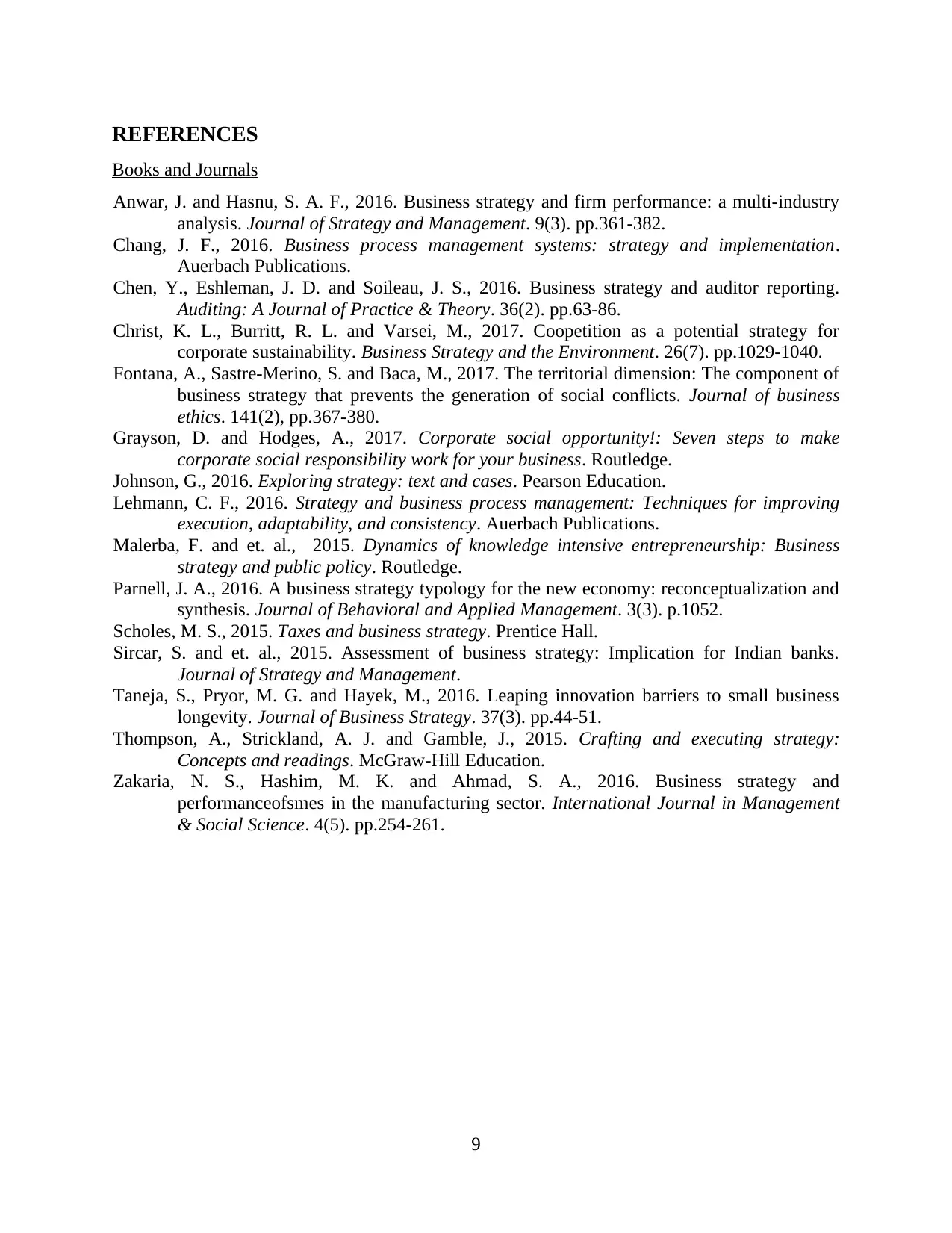
REFERENCES
Books and Journals
Anwar, J. and Hasnu, S. A. F., 2016. Business strategy and firm performance: a multi-industry
analysis. Journal of Strategy and Management. 9(3). pp.361-382.
Chang, J. F., 2016. Business process management systems: strategy and implementation.
Auerbach Publications.
Chen, Y., Eshleman, J. D. and Soileau, J. S., 2016. Business strategy and auditor reporting.
Auditing: A Journal of Practice & Theory. 36(2). pp.63-86.
Christ, K. L., Burritt, R. L. and Varsei, M., 2017. Coopetition as a potential strategy for
corporate sustainability. Business Strategy and the Environment. 26(7). pp.1029-1040.
Fontana, A., Sastre-Merino, S. and Baca, M., 2017. The territorial dimension: The component of
business strategy that prevents the generation of social conflicts. Journal of business
ethics. 141(2), pp.367-380.
Grayson, D. and Hodges, A., 2017. Corporate social opportunity!: Seven steps to make
corporate social responsibility work for your business. Routledge.
Johnson, G., 2016. Exploring strategy: text and cases. Pearson Education.
Lehmann, C. F., 2016. Strategy and business process management: Techniques for improving
execution, adaptability, and consistency. Auerbach Publications.
Malerba, F. and et. al., 2015. Dynamics of knowledge intensive entrepreneurship: Business
strategy and public policy. Routledge.
Parnell, J. A., 2016. A business strategy typology for the new economy: reconceptualization and
synthesis. Journal of Behavioral and Applied Management. 3(3). p.1052.
Scholes, M. S., 2015. Taxes and business strategy. Prentice Hall.
Sircar, S. and et. al., 2015. Assessment of business strategy: Implication for Indian banks.
Journal of Strategy and Management.
Taneja, S., Pryor, M. G. and Hayek, M., 2016. Leaping innovation barriers to small business
longevity. Journal of Business Strategy. 37(3). pp.44-51.
Thompson, A., Strickland, A. J. and Gamble, J., 2015. Crafting and executing strategy:
Concepts and readings. McGraw-Hill Education.
Zakaria, N. S., Hashim, M. K. and Ahmad, S. A., 2016. Business strategy and
performanceofsmes in the manufacturing sector. International Journal in Management
& Social Science. 4(5). pp.254-261.
9
Books and Journals
Anwar, J. and Hasnu, S. A. F., 2016. Business strategy and firm performance: a multi-industry
analysis. Journal of Strategy and Management. 9(3). pp.361-382.
Chang, J. F., 2016. Business process management systems: strategy and implementation.
Auerbach Publications.
Chen, Y., Eshleman, J. D. and Soileau, J. S., 2016. Business strategy and auditor reporting.
Auditing: A Journal of Practice & Theory. 36(2). pp.63-86.
Christ, K. L., Burritt, R. L. and Varsei, M., 2017. Coopetition as a potential strategy for
corporate sustainability. Business Strategy and the Environment. 26(7). pp.1029-1040.
Fontana, A., Sastre-Merino, S. and Baca, M., 2017. The territorial dimension: The component of
business strategy that prevents the generation of social conflicts. Journal of business
ethics. 141(2), pp.367-380.
Grayson, D. and Hodges, A., 2017. Corporate social opportunity!: Seven steps to make
corporate social responsibility work for your business. Routledge.
Johnson, G., 2016. Exploring strategy: text and cases. Pearson Education.
Lehmann, C. F., 2016. Strategy and business process management: Techniques for improving
execution, adaptability, and consistency. Auerbach Publications.
Malerba, F. and et. al., 2015. Dynamics of knowledge intensive entrepreneurship: Business
strategy and public policy. Routledge.
Parnell, J. A., 2016. A business strategy typology for the new economy: reconceptualization and
synthesis. Journal of Behavioral and Applied Management. 3(3). p.1052.
Scholes, M. S., 2015. Taxes and business strategy. Prentice Hall.
Sircar, S. and et. al., 2015. Assessment of business strategy: Implication for Indian banks.
Journal of Strategy and Management.
Taneja, S., Pryor, M. G. and Hayek, M., 2016. Leaping innovation barriers to small business
longevity. Journal of Business Strategy. 37(3). pp.44-51.
Thompson, A., Strickland, A. J. and Gamble, J., 2015. Crafting and executing strategy:
Concepts and readings. McGraw-Hill Education.
Zakaria, N. S., Hashim, M. K. and Ahmad, S. A., 2016. Business strategy and
performanceofsmes in the manufacturing sector. International Journal in Management
& Social Science. 4(5). pp.254-261.
9
1 out of 11
Related Documents
Your All-in-One AI-Powered Toolkit for Academic Success.
+13062052269
info@desklib.com
Available 24*7 on WhatsApp / Email
![[object Object]](/_next/static/media/star-bottom.7253800d.svg)
Unlock your academic potential
© 2024 | Zucol Services PVT LTD | All rights reserved.





